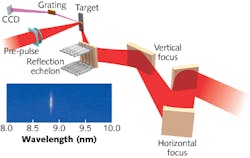Demonstration of a 13 nm tabletop x-ray source that could achieve 25-nm-resolution imaging in only 30 s (compared to 30–50 nm resolution in 80 min from prior sources), as reported in Laser Focus World’s July 2011 issue, was indeed impressive. But now, a team of researchers from the NSF Engineering Research Center for Extreme Ultraviolet Science and Technology (NSF EUV ERC) and Colorado State University (both in Fort Collins, CO), in collaboration with the University of California–Berkeley, and Oak Ridge National Laboratory (Oak Ridge, TN), have demonstrated a high-pulse-energy, 8.8 nm tabletop x-ray laser source that operates at a 1 Hz repetition rate.1 Previous attempts to shorten the x-ray wavelength below 10.9 nm in plasma-based schemes typically limited the repetition rate to a few shots per hour.
Lower pump energy
Until recently, soft-x-ray lasers at wavelengths below 10 nm were created by pumping appropriate materials with tens of joules of energy. To achieve gain-saturated 8.8 nm lasing from a 1-to-2-mm-thick solid nickel-like lanthanum (La) target, the researchers pumped in only 7.5 J of optical energy.
The pump setup consists of two pulses from an 800 nm Ti:sapphire laser (see figure). The first normal-incidence prepulse has a 6 × 1012 W/cm2 intensity with 210 ps full-width half-maximum (FWHM) duration and creates a 30 μm × 6.4 mm line focus via spherical and cylindrical lenses. This prepulse rapidly heats the plasma, resulting in a significant percentage of ions in the Ni-like state (La+29). After the plasma expands, a second 4 J, 6 × 1014 W/cm2 pulse with 3 ps FWHM duration is delivered at a grazing-incidence angle of 35º, heating the plasma to an electron temperature of approximately 850 eV and efficiently exciting ions to the laser’s upper level. This angle of incidence, along with focusing elements to maintain a uniform 30 μm × 6.4 mm line focus, allows refraction to efficiently couple the pump-beam energy into the plasma and maximize x-ray emission.
To overcome the mismatch between the propagation velocities of the pump pulse and the amplified pulse, which normally limits the output, a five-mirror-segment reflection echelon was used to obtain quasi-traveling-wave excitation, significantly improving the laser output.
Measurements at the 1 Hz repetition rate were made by moving the La target at a rate of 200 μm/s to renew the surface after each laser shot. Operation of the soft-x-ray laser source at 8.85 nm reaches gain saturation with approximately 2.7 μJ of pulse energy, a gain coefficient of 33 cm-1, and a gain-length product of 14.6.
Even shorter wavelengths
By reducing the duration of the main pump pulse to just 1.1 ps, the research team also demonstrated lasing at 7.36 nm in nickel-like samarium. As diode-pumped optical laser sources continue to improve, so too will sub-10-nm tabletop x-ray laser sources, which are instrumental in enabling such applications as sequential imaging of ultrafast nanoscale dynamic phenomena.
“These soft x-ray laser sources have the potential to enable tabletop-scale applications that require high pulse energy such as high-density plasma diagnostics or high average power such as nanoscale imaging and nanoscale dynamics studies,” says David Alessi, a postdoctoral researcher at Lawrence Livermore National Laboratory (Livermore, CA), formerly in Jorge Rocca’s group at the NSF EUV ERC. “The NSF EUV ERC will continue research and development of sub-10-nm soft x-ray lasers with the goals of improving their spatial and temporal characteristics and increasing their pulse energy.”
REFERENCE
1. D. Alessi et al., Phys. Rev. X, 1, 2, 021023 (Sept. 27, 2011).

Gail Overton | Senior Editor (2004-2020)
Gail has more than 30 years of engineering, marketing, product management, and editorial experience in the photonics and optical communications industry. Before joining the staff at Laser Focus World in 2004, she held many product management and product marketing roles in the fiber-optics industry, most notably at Hughes (El Segundo, CA), GTE Labs (Waltham, MA), Corning (Corning, NY), Photon Kinetics (Beaverton, OR), and Newport Corporation (Irvine, CA). During her marketing career, Gail published articles in WDM Solutions and Sensors magazine and traveled internationally to conduct product and sales training. Gail received her BS degree in physics, with an emphasis in optics, from San Diego State University in San Diego, CA in May 1986.
